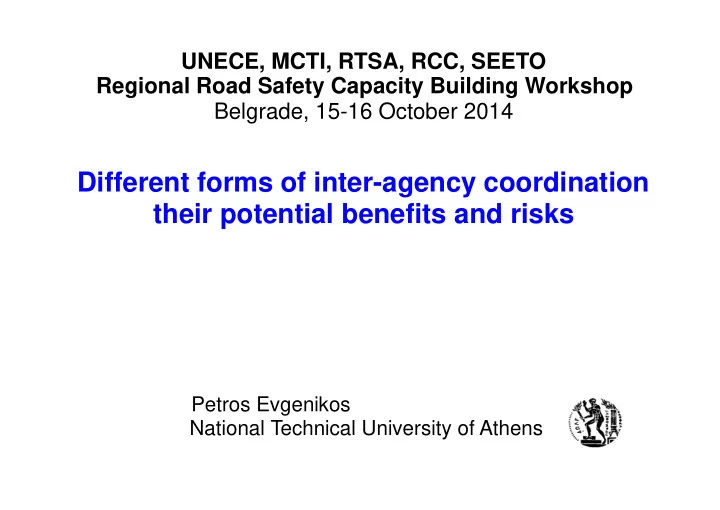

UNECE, MCTI, RTSA, RCC, SEETO Regional Road Safety Capacity Building Workshop Belgrade, 15-16 October 2014 Different forms of inter-agency coordination their potential benefits and risks Petros Evgenikos National Technical University of Athens
Inter-agency coordination is a difficult and controversial issue, is not good per se and it is important not to oversell the benefits of coordination. It should be pursued only if it results to better organizational performance. Inter-agency coordination at national level: o There are programs and actions (i.e. road safety education) shared between various Ministries and good cooperation between the relevant agencies and departments is necessary to optimize the expected outputs. o Coordination between the regional services that implement the various programs is also needed. o Synergies between governmental agencies and Municipal authorities and local communities for the identification of road safety issues at local road environment. o Communication and cooperation between the Ministry supervised bodies, the relevant departments of other Ministries and bodies of the public and private sector engaged in relevant policies is essential, to promote common actions in order to improve the level of road safety in the country.
The example of Finland : The Ministry of Transport and Communication is responsible for road safety in Finland. The Consultative Committee on Road Safety acts as the Advisory Committee of the Ministry of Transport and is responsible for preparing the national strategy. Governmental agencies in each province (State Provincial Offices) coordinate road safety activities of Municipalities that require the cooperation of many stakeholders through the Provincial Traffic Safety Committees, in which representatives of major road safety stakeholders are participating. The Traffic Planning Departments determine the road safety targets for each province, are responsible for the planning and implementation of actions and are reporting to the Ministry of Transport. At local level, road safety actions are undertaken by the Municipalities. Depending on the size and circumstances of each Municipality, the actions are carried out by the Municipality itself or in cooperation with other Municipalities.
Inter-agency coordination at international level: o International police cooperation: Establishment of a network of police services and the competent authorities, i.e. in the field of driving licenses and tachographs. o Cross-border collaboration for road safety enforcement. Strong need to develop and adopt legislation to harmonize enforcement between Member States (harmonized uniform fines for violations and convergence of control mechanisms through harmonization of enforcement systems). o European Commission Agencies to work closely with the Member States for the formulation of a common strategy for education and training in road safety.
Three forms of inter-agencies coordination: o Intergovernmental or Vertical coordination : involves the joint action of agencies belonging to different government levels (i.e. national, regional, local). The mix of government levels and the assignment of responsibilities can vary significantly across coordinated programs. The common recommendation is for higher levels to have a normative, funding, and monitoring role while lower levels of government play a design and implementation role. o Intersectoral or Horizontal coordination : involves the joint action of agencies from different sectors (i.e. health agencies and police agencies) o Public-Private coordination : coordination between public, non-profit, for- profit organisations.
Benefits of inter-agency coordination: o The causes of road accidents are multiple and very often interrelated, and therefore tackling them requires an intersectoral, common approach. o Coordination can generate economies of scale. o The fragmentation of multiple and overlapping targeted road safety programs and policies requires coordination at the activities implementation level. o Financial advantages by obtaining extra resources (financial resources and staff). o Political benefits through the establishment of relationships with other organizations that can bring prestige, power or other benefits (especially for Public administrations). o Exchange of experiences, knowledge and technical expertise under different perspectives and improved data and information use. o Increase of programs efficiency and facilitation of long-term planning by avoiding ad-hoc activities.
Obstacles to inter-agency coordination: o Each agency seeks to preserve its autonomy and independence. o Each agency loses some of its freedom to act independently, does not maintain control over its domain and affairs, it must invest scarce resources and energy to develop and maintain relationships with other organizations, when the potential returns on this investment are often unclear and intangible. o Organizational routines and procedures are by nature difficult to synchronize and coordinate. o Organizational goals differ among collaborating agencies. o Different components bring different expectations and pressure to bear on each agency.
Risks of inter-agency coordination: o Resistance to exchange information, feet dragging and slow implementation. o Longer implementation period due to necessary time allocation to coordinate different agencies. o Differences in perspective leads to focusing on different aspects of a road safety problem and to rely on different intervention strategies. o Difficulties in generating a common sense of purpose around the program/activities concept among the different agencies. o Failure in coordinating each agency seeks to preserve its autonomy and independence. o Additional managerial burden and significant resources expenditure to coordinate large number of agencies.
Requirements for effective inter-agency coordination: o Seeing coordination as an ongoing process rather than a fixed outcome. o The role and responsibilities of each involved party should be distinct and clearly defined through established procedures within a legislative framework. o Coordination of all authorities and bodies by a Central Governmental Authority. o Effective leadership not only at higher level. Flexibility - Revise occasionally responsibilities and planning. o Building a common sense of purpose by fostering mutual intelligibility and o trust among professionals from the different agencies. o Engage all parties at the different levels (planning – design – implementation). o Keep the number of coordinated agencies limited to the absolutely necessary. o Replace the bureaucratic culture by a culture of results-oriented pragmatism. o Minimize political turbulence from new governments in power, personnel turnover in leadership positions, or the emergence of a new political agenda.
Recommend
More recommend